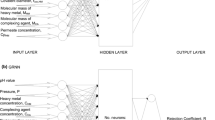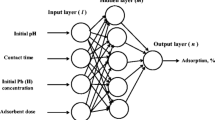Abstract
The assessment of heavy metal transition from Ni–Cd zinc plant residue (filtercake), as concentrations of zinc, nickel, cadmium and lead, requires quantification and a mathematical model that predicts their relative concentrations. Variability of filtercake characteristics may change the availability of heavy metals to the leachate or environment. In this study, a novel artificial neural network (ANN) model was constructed to predict Zn, Ni, Cd and Pb concentration leached from Ni–Cd filtercake in the leaching column. A three-layer backpropagation neural network was optimized and developed based on the Bayesian training algorithm. The inputs of this network are pH, flow rate of acidic influent, particle size and time. The geometry of the network giving the minimized mean square error (MSE) and sum of squared error (SSE) was a three-layer network having 18 neurons in the hidden layer (4:18:4) with a tangent sigmoid transfer function (tansig) at the hidden layer and linear transfer function (purelin) at the output layer. The fitting, regression, error and histogram plots for each response illustrate that there is a good agreement between the experimental data and the predicted values. Finally, a generalization of the developed model was carried out as 3D plots to evaluate the interactions of the input parameters on the transition of heavy metals to the leachate. With respect to these results, the effect of particle size on concentrations of zinc, nickel and lead are less (<3 mg/L) than that of cadmium (<3 mg/L). Furthermore, it was found that, at low flow rate, the concentrations of extracted metals are high due to enhancement of exposure residence time (between particles and leach solution).













Similar content being viewed by others
Reference
Safarzadeh M S, Moradkhani D and Ashtari P, Hydrometallurgy 97 (2009) 67.
Safarzadeh M S, Moradkhani D, Ilkhchi M O and Golshan N H, Sep Purif Technol 58 (2008) 367.
Corkhill C L and Vaughan D J, Appl Geochem 24 (2009) 2342.
ACAT and REDOIL, Mining and Toxic Metals: A case study of the proposed Donlin Creek mine.
Johnson D B and Hallberg K B, Sci Total Environ 338 (2005) 3.
Buszewski, B and Kowalkowski T, Environ Eng sci 23 (2006) 589.
Anagu I, Ingwersen J, Utermann J and Streck T, Geoderma 152 (2009) 104.
Buszewski B and Kowalowski A T, Environ Eng Sci 23 (2006) 589.
Hinz C and Selim H M, Soil Sci Soc Am J 58 (1994) 1316.
Kent D B, Abrams R H, Davis J A, Coston J A and LeBlanc D R, Water Resour Res 36 (2000) 3411.
Kolahchi Z and Jalali M, Agric Water Manag 85 (2006) 85.
Sayyad G, Afyuni M, Mousavi S-F, Abbaspour K C, Richards B K and Schulin R, Geoderma 154 (2010) 311.
Bianchi Janetti E, Dror I, Riva M, Guadagnini A, Sanchez-Vila X and Berkowitz B, Transp Porous Med 97 (2013) 295.
Altin O, Ozbelge O H and Dogu T, J Chem Technol Biotechnol 74 (1999) 1139.
van der Zee S E A T M and Van Riemsdijk W H, Water Resour Res 23 (1987) 2059.
Springob, G and J Böttcher, Zeitschrift für Pflanzenernährung und Bodenkunde. 161 (1998) 681.
Wilkins B J, Brummel N and Loch J P G, Water, Air, Soil Pollut 101 (1998) 349.
Kookana R S and Naidu R, Geoderma 84 (1998) 235.
Streck T and Richter J, J Environ Qual 26 (1997) 56.
Hattab N, Hambli R, Motelica-Heino M, Bourrat X and Mench M, J Geochem Explor 128 (2013) 25.
Bayar S, Demir I and Engin G O, Ecotoxicol Environ Saf 72 (2009) 843.
Kaluli J W, Madramootoo C A and Djebbar Y, Water Sci Technol 38 (1998) 127.
Poon C S and Lio K W, Waste Manag 17 (1997) 15.
Deopker R and O’Connor W, Mine Water Environ 10 (1991) 57.
Jackson D R, Garrett B C and Bishop T A, Environ Sci Technol 18 (1984) 668.
Li X, You F, Huang L, Strounina E and Edraki M, Environ Sci Eur 25 (2013) 1.
Tu J V, J Clin Epidemiol 49 (1996) 1225.
Kamran Haghighi H, Moradkhani D and Salarirad M M, Trans Indian Inst Met 67 (2014) 331.
Moradkhani D, Sedaghat B and Khodadadi A, Environmental assessment of the potential for heavy metals leaching, in EMC 2011, Europe (2011).
B Y, Artificial Neural Networks, Hall of India Private Limited, New Delhi (2006).
Elmolla E S, Chaudhuri M and Eltoukhy M M, J Hazard Mater 179 (2010) 127.
Karimi F, Rafiee S, Taheri-Garavand A and Karimi M, Optimization of an air drying process for Artemisia absinthium leaves using response surface and artificial neural network models. J Taiwan Inst Chem Eng. Vol. 43. 2012: AAAA. 29.
Anderson J, An introduction to neural networks. 1995, New Delhi: Prentice-Hall.
Khan M S and Coulibaly P, Water Resour Res 42 (2006) W07409.
Schalkoff R J, Artificial Neural Networks, McGraw-Hill, New York (1997).
Twomey J M and Smith A E, Math Comput Model 21 (1995) 243.
Messikh N, Samar M H and Messikh L, Desalination 208 (2007) 42.
Miller J D, Lin C L and Roldan C. Particle size distribution for copper heap leaching operations as established from 3D mineral exposure analysis by X-ray microCT. in COPPER 2003-COBRE 2003 Santiago, Chile, (2003)
Sheikhzadeh G A, Mehrabian M A, Mansouri S H and Sarrafi A, Int J Heat Mass Trans 48 (2005) 279.
Agatzini-Leonardou S and Zafiratos I G, Hydrometallurgy 74 (2004) 267.
Quaicoe I, Nosrati A, Skinner W and Addai-Mensah J, Miner Eng 65 (2014) 1.
Author information
Authors and Affiliations
Corresponding author
Rights and permissions
About this article
Cite this article
Kamran Haghighi, H., Rafie, M., Moradkhani, D. et al. Modeling on Transition of Heavy Metals from Ni–Cd Zinc Plant Residue Using Artificial Neural Network. Trans Indian Inst Met 68, 741–756 (2015). https://doi.org/10.1007/s12666-014-0507-3
Received:
Accepted:
Published:
Issue Date:
DOI: https://doi.org/10.1007/s12666-014-0507-3




